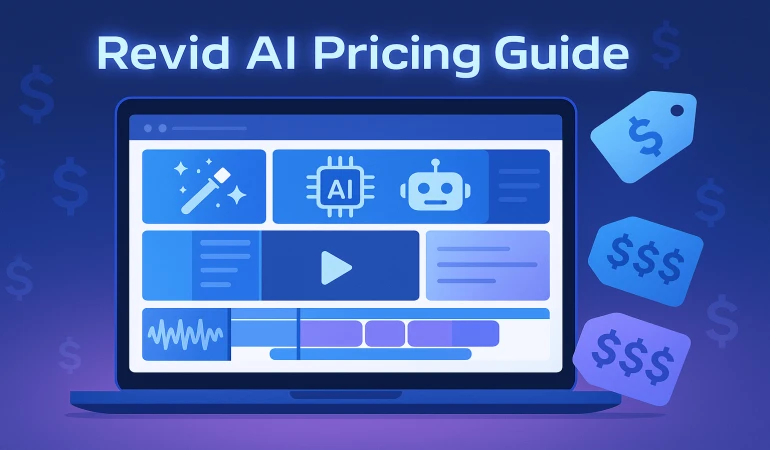How to Create a Faceless Video: Best Practices and Strategies
You don't know how to create a faceless video using AI? Faceless videos are perfect for sharing your ideas without showing your face on camera. In this step-by-step guide, I'll show you the best steps, tips, and strategies on how to create an AI faceless video easily. So, read on to discover how you can start creating engaging high quality faceless videos today!
July 11, 2024 17:07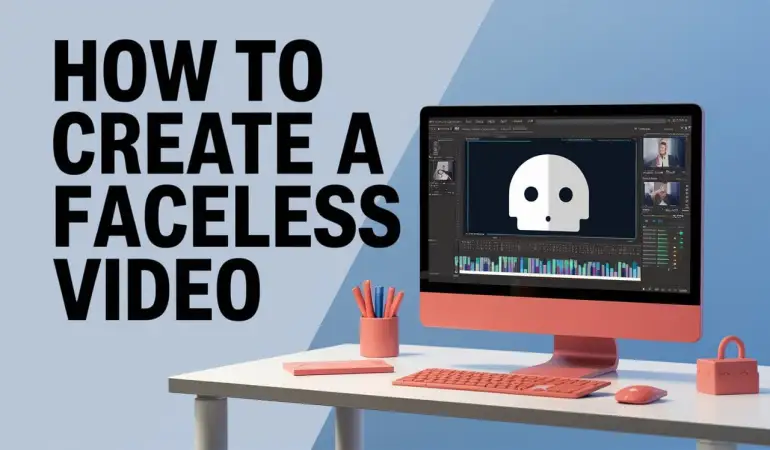
How to Create a Faceless Video Professionally
Knowing how to create a faceless video is crucial if you're operating or planning to start a faceless YouTube channel and TikTok.
Let's take a look at the steps on how to create an AI faceless video.
Step 1: Choose an AI Faceless Video Generator
To start, you need to pick a tailored AI faceless video generator. Here are some popular ones:
Vidnoz AI: Vidnoz AI offers many templates and avatars. It has text-to-speech features and allows you to customize visuals and audio.
Faceless.video: Faceless.video helps you create and post videos on TikTok and YouTube. You can explore amazing Faceless.video alternative tools here.
Submagic: Submagic is known for its simple interface and customizable options.
Invideo AI: Invideo AI has many AI features to help you make professional faceless videos.
AutoShorts AI: AutoShorts AI can help you automate a faceless YouTube channel and TikTok by auto-creating faceless videos on Auto-Pilot for your channel.
Nullface AI: Nullface AI can create a faceless video for you by just imputing your video concept. You can even choose voices and background images that suit you.
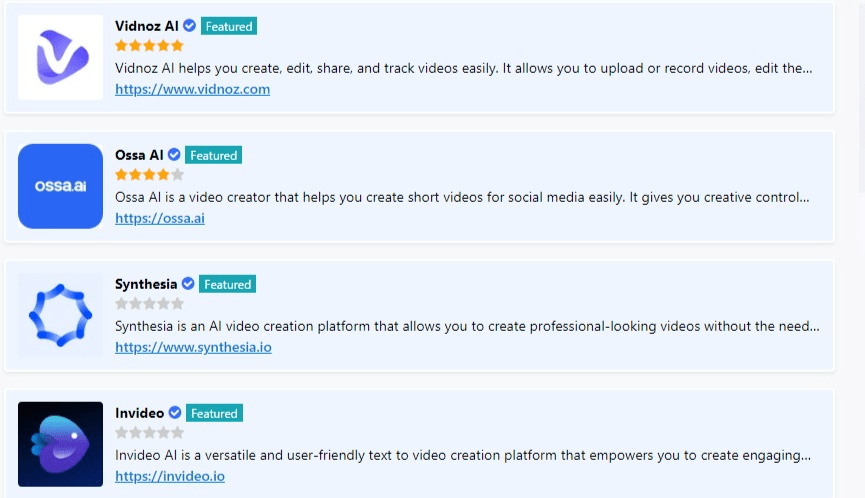
These faceless AI video generators help you create videos without needing advanced skills. They provide templates and easy customization options for you.
Step 2: Develop Your Video Concept or Idea
Next, you need to come up with a video concept or idea. Think about these points:
Who is your target audience?
Which platform will you use? (e.g., YouTube, TikTok, Facebook, Instagram etc.)
What tone and style will your video have?
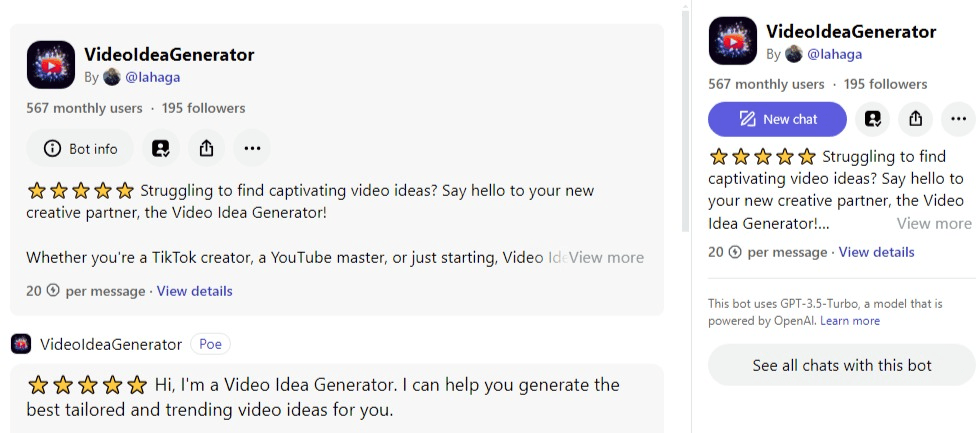
Outline the key points or the story you want to tell. This helps you stay focused and organized. You can use this powerful Video Idea Generator to generate amazing video ideas.
Step 3: Write the Video Script
A good script is key to a successful video. Make sure your script is clear and engaging. Keep these tips in mind:
Use simple and direct language.
Make sure it is easy to convert to speech.
Add calls-to-action or interactive elements to keep viewers engaged.
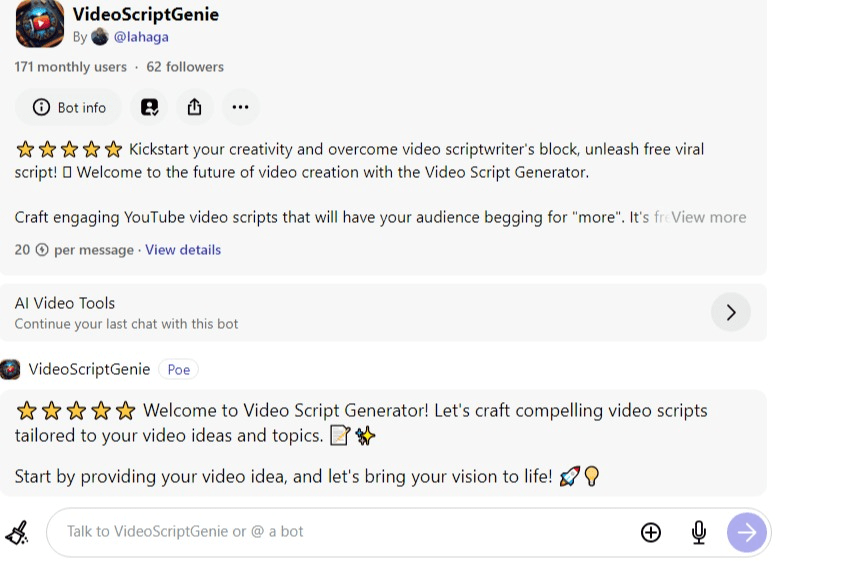
Writing a script helps you plan your video and ensures you cover all important points. Use this amazing Video Script Generator to generate your video scripts.
Step 4: Generate the Video
Now, it's time to create your video. Use the faceless AI video generator you selected in step 1. These video tools are designed to be user-friendly, even if you don’t have technical skills.
Auto Generate the Video
Enter the video script you generate using the Video Script Generator into the script editor of the AI faceless video generator you choose and generate your video using AI.
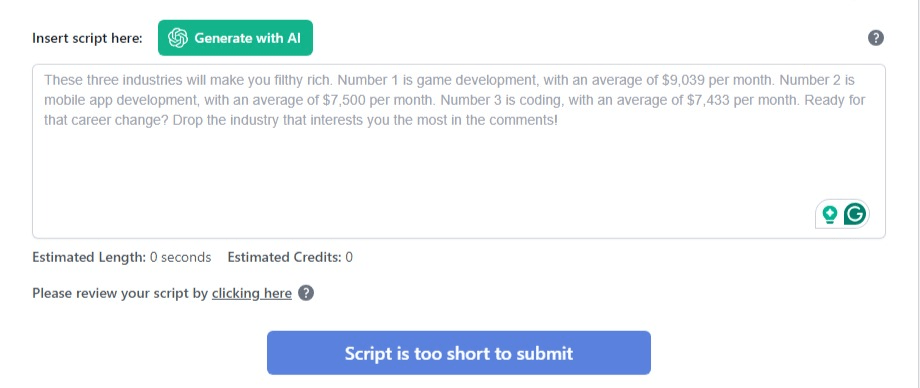
Customize Avatars
Choose or create characters that fit your video’s theme. Most AI video tools offer a variety of avatars you can customize with different features, clothes, and expressions.
Use Templates
Templates help you structure your video. They provide a pre-made format that you can fill with your content. Experiment with different templates to find the best one for your message.
Pick a template that has the background that suits your video’s topic. You can choose from a library of scenes or upload your own.
Step 5: Add Audio and Some Finishing Touches
After generating the video, you need to add audio and other finishing touches.
Note: Some AI faceless video generator tools like Ossa AI and Nullface AI automatically add audio during generation and some faceless video tools like Invideo AI and FlexClip allow you to customize the audio even after generation.
Text-to-Speech
Select a text-to-speech voice that matches the tone of your video. AI video tools offer different voices with varying accents, pitches, and speeds.
Adjustments: Adjust the speaking pace to ensure clarity. A slower pace is often easier for viewers to follow.
Tone: Choose a tone that fits the mood of your video. Whether it’s formal, casual, or enthusiastic, the right tone can enhance your message.
Background Music
Adding background music can make your video more engaging. Choose music that complements your content. Make sure the volume of the music does not overpower the speech.
Sound Effects
Use sound effects to emphasize key points or to add fun elements to your video. This can make your video more dynamic and interesting.
Review and Edit
Before finalizing, review your video. Look for any mistakes or areas that need improvement. Most faceless AI video generators allow you to trim clips, adjust audio levels, and tweak visuals.
Step 6: Review and Publish
The last step is to review and publish your video.
Preview the Video: Watch your video from start to finish. Ensure that it flows well and everything looks and sounds good.
Make Adjustments: If you notice any issues, go back and fix them. This could be anything from a typo in the text to an audio mismatch.
Publish: Once you are satisfied with your video, it’s time to publish. Upload your video to your chosen platform, like YouTube, TikTok or Facebook.
Here are some additional tips for a smooth publishing process:
Video Title: Choose a clear and catchy title that includes your keyword. Example: “How to create a faceless video.”
Description: Write a detailed description with relevant keywords. This helps your video rank higher in search results.
Tags: Use tags that are relevant to your video. Tags help your video get discovered by people searching for related content.
Common Mistakes to Avoid When Creating a Faceless Video
When learning how to create a faceless video, it's important to be aware of potential pitfalls. By avoiding these common mistakes, you can ensure your faceless videos are engaging, professional, and effective. Let's explore some key errors to steer clear of:
1. Neglecting Script Quality
One of the biggest mistakes is underestimating the importance of a well-written script. Remember, without your face to convey emotions, your words carry even more weight.
Poor Planning: Failing to outline your content can lead to rambling or disorganized videos.
Ignoring Tone: Your script should match the tone of your visuals and target audience.
Lack of Engagement: Forgetting to include hooks or calls-to-action can result in viewer drop-off.
2. Overloading with Information
It's tempting to pack your video with as much information as possible, but this can overwhelm viewers.
Too Much Text: Crowding your video with text makes it hard to read and follow.
Rapid Pacing: Moving too quickly through points can lose your audience.
Complex Language: Using jargon or complicated terms can alienate viewers.
3. Poor Audio Quality
In faceless videos, audio becomes even more crucial. Poor audio can quickly turn viewers away.
Background Noise: Failing to record in a quiet environment can distract from your message. You can use Audioenhancer.ai to enhance the audio.
Inconsistent Volume: Fluctuations in audio levels can be jarring for listeners.
Low-Quality Voiceovers: Using subpar text-to-speech tools can make your video sound robotic and unprofessional.
4. Ignoring Visual Appeal
Just because you're not on camera doesn't mean visuals aren't important.
Boring Visuals: Using static and high-quality images or bland backgrounds can make your video unengaging.
Mismatched Styles: Inconsistent visual elements can make your video look unprofessional.
Poor Color Choices: Using colors that clash or are hard to read can detract from your message.
5. Forgetting Your Audience
It's easy to get caught up in the technicalities and forget who you're creating for.
Mismatched Content: Creating videos that don't align with your audience's interests or needs.
Lack of Value: Failing to provide actionable insights or valuable information.
Ignoring Feedback: Not paying attention to comments and audience reactions to improve future videos.
6. Inconsistent Branding
Your faceless videos should still reflect your brand identity.
Changing Styles: Using different visual styles or voices across videos can confuse your audience.
Missing Logo: Forgetting to include your brand logo or signature elements.
Inconsistent Messaging: Delivering conflicting messages across different videos.
If you avoid these common mistakes, you'll be well on your way to creating engaging, effective faceless videos. Remember, practice makes perfect - don't be discouraged if your first attempts aren't flawless.
Keep refining your skills, and soon you'll be a pro at creating faceless videos that captivate your audience and deliver your message effectively.
The Importance of Creating Faceless Videos
Creating faceless videos has many benefits. Some of them are:
You don’t need to be on camera.
You can create content faster.
You can use animations or AI visuals for creativity.
Understanding Faceless Video Formats
There are different types of faceless videos. Here are the main ones:
Screen Recordings
Screen recordings capture what you do on your computer screen. They are great for tutorials and demonstrations. You can show how to use software, navigate websites, or explain processes.
Animations
Animations use drawn characters and scenes to tell a story. This can make your content more engaging and fun. You don’t need to draw yourself. There are AI video animation tools that help you create animations easily.
Stock Footage
Stock footage uses pre-made video clips. These clips are often professional and high-quality. You can find clips of people, places, and activities to fit your content. This saves time and gives your videos a polished look.
AI-Generated Visuals
AI-generated visuals are made by artificial intelligence. These video tools create unique and personalized visuals for your videos. This gives your content a modern and innovative feel.
Conclusion
I hope now you know how to create a faceless video. Creating faceless videos with AI is a powerful way to share your ideas and stories while maintaining your privacy. By following the steps outlined in this guide, you can master how to create a faceless video.
Remember to optimize your videos for search engines, engage with your audience, analyze performance, stay consistent, foster community, and adapt to changes.
Start experimenting with AI faceless video generator tools today and see how they can transform your content creation process. With creativity and dedication, your faceless videos can reach and engage a wide audience, helping you achieve your goals.
Frequently Asked Questions
Let's answer some questions people ask about faceless videos.
What Is a Faceless Video?
A faceless video is a type of video content that communicates its message without showing a person's face using visuals like animations, text, stock footage, and AI avatars.
Do Faceless Videos Make Money?
Yes! Faceless videos can generate income through YouTube ads, sponsorships, and affiliate marketing. With engaging content and tools like Faceless.Video, you can attract viewers and monetize your faceless videos effectively.
Is Faceless.Video Safe to Use?
Yes. Faceless.Video provides a secure platform for creators. It offers privacy by not requiring personal footage, and letting you create professional faceless videos without exposing yourself.
What Is the Best Faceless Video Software?
There are many best software for creating faceless videos. Some of them include VideoExpress AI, Vidnoz AI, Ossa AI, AutoShorts AI, HumanPal, Invideo AI etc. These software are the top choice for creating faceless videos due to their user-friendly interface, customizable templates, and ability to produce polished faceless videos without advanced technical skills.
Can I Earn From YouTube Without Showing My Face?
Yes, you can! Many YouTubers use faceless videos to build profitable channels. Faceless.Video can help you create high-quality videos with visuals and voiceovers that engage viewers, perfect for earning without being on camera.





